Davao de Oro
Davao de Oro, officially the Province of Davao de Oro and formerly known as Compostela Valley (Cebuano: Lalawigan sa Davao de Oro; Filipino: Lalawigan ng Davao de Oro), is a province in the Philippines located in the Davao Region in Mindanao. Its capital is Nabunturan. It used to be part of the province of Davao del Norte until it was made a separate province in 1998 and given the name Compostela Valley (Cebuano: Kawalogang Kompostela; shortened as ComVal), which was used until 2019.
Davao de Oro Compostela Valley | |
|---|---|
| Province of Davao de Oro | |
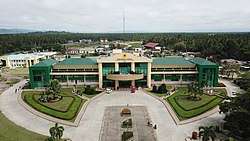 Provincial Capitol | |
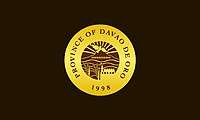 Flag 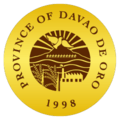 Seal | |
| Etymology: Davao de Oro (lit., "Golden Davao") | |
| Nickname(s): Golden Capital of the Philippines | |
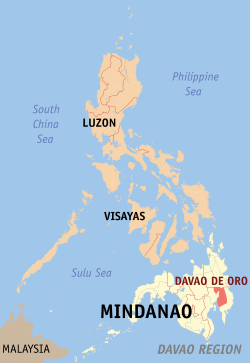 Map of Davao Region with Davao de Oro highlighted | |
| Coordinates: 7°36′N 125°57′E | |
| Country | Philippines |
| Region | Davao Region (Region XI) |
| Founded | 8 March 1998 |
| Renamed | 7 December 2019 |
| Capital | Nabunturan |
| Government | |
| • Type | Sangguniang Panlalawigan |
| • Governor | Jayvee Tyron L. Uy (PDP-Laban) |
| • Vice Governor | Maria Carmen S. Zamora (PDP-Laban) |
| Area | |
| • Total | 4,479.77 km2 (1,729.65 sq mi) |
| Area rank | 26th out of 81 |
| Highest elevation (Mount Pandadagsaan) | 2,670 m (8,760 ft) |
| Population (2015 census)[2] | |
| • Total | 736,107 |
| • Rank | 40th out of 81 |
| • Density | 160/km2 (430/sq mi) |
| • Density rank | 53rd out of 81 |
| Demonym(s) | Orocanon, Oroqueño |
| Divisions | |
| • Independent cities | 0 |
| • Component cities | 0 |
| • Municipalities | |
| • Barangays | 237 |
| • Districts | 1st and 2nd districts of Davao de Oro |
| Time zone | UTC+8 (PHT) |
| ZIP Code | 8800–8810 |
| IDD : area code | +63 (0)87 |
| ISO 3166 code | PH-COM |
| Spoken languages |
|
| Income classification | 1st class |
| Website | www |
It is the fourth newest province of the Philippines, behind Zamboanga Sibugay, Dinagat Islands, and Davao Occidental. The province borders Davao del Norte to the west, Agusan del Sur to the north, and Davao Oriental to the east. To the southwest lies the Davao Gulf. The first elected governor was Jose Caballero, formerly a lawyer for a mining group in the province.
The province official name was Compostela Valley from its inception until December 2019, after which voters in a plebiscite ratified the law which changed the name of the province to Davao de Oro.
History
Davao de Oro, the 78th province in the country, was created out of Davao del Norte Province by virtue of Republic Act No. 8470, signed by President Fidel V. Ramos on January 30, 1998. The new province was officially named Compostela Valley.[3] On March 7 of the same year, the law was ratified through a plebiscite conducted in the twenty-two (22) municipalities of the mother province.
The movement to create a new province by dividing Davao del Norte started in the 1980s during the time of Congressman Lorenzo S. Sarmiento, Sr., himself the author of RA No. 6430. However, this was not realized until his death in the late 1980s. His son, Rogelio M. Sarmiento, who became his successor in Congress, pushed for the passage of the bill creating the province.
Upon consultation with the governor of Davao del Norte, Prospero S. Amatong, the province’s other two legislators, 3rd District Congressman Rodolfo P. Del Rosario and 2nd District Congressman Baltazar A. Sator, and other provincial and municipal officials, it was decided that the addition of four municipalities, namely Maco, Mabini, Pantukan, and Laak to the proposed province would be the most ideal and equitable configuration as this would make both provinces on an almost equal footing in terms of area, population, and development opportunities. It was also decided that Nabunturan would be the capital town because of its more central location.
The name originally proposed for the province was Davao del Norte, the former name, or so it was thought, of the mother province. However, the House of Representatives’ Reference and Research Bureau which conducted the research and legal work on the creation of the province found out that the mother province continues to be officially referred to as Davao del Norte in most official documents including the 1987 Philippine Constitution despite the passage of RA No. 6430 on June 17, 1972 renaming it as Davao Province. Tedious technical and legal issues needed to be resolved before the name could be adopted, the proposal was thus, shelved and the name finally agreed upon was Compostela Valley, referring to the great fertile plain in the heartland of the province.
The origin of the province’s inhabitants came from the ethnic tribes of the Mansaka, Mandaya, Manobo, Mangguangan, Dibabawon, Aeta, Kamayo, Davaweño and Kalagan. Similar to the history of other Mindanao provinces, most of the present populations of the province are descendants of migrants who came from Luzon and Visayas islands during the pre-war and post war eras. The bigger wave of immigrants came during the time of President Ramon Magsaysay wherein the policy of attraction adopted by the national government was to offer parcels of land to tenant-farmers. Although a virtual melting pot, the Visayans (mostly Cebuano-speaking) are the dominant group in Davao de Oro.
New, as it is, Davao de Oro has achieved a distinction of sorts with the succession of three governors during the first four months of its existence. The first governor of the province was Prospero S. Amatong, the three-term governor (1986-1998) of the then undivided province of Davao del Norte, who held the position only for a day. As provided for in the law creating the new province, "incumbent elected officials (of Davao del Norte) are given option to serve the remainder of their term in Compostela Valley," Amatong took this option and assumed the governorship of the then-Compostela Valley on March 26, 1998. The following day, he resigned and filed his candidacy for the congressional seat of the 2nd district of the new province. The governorship was turned over to Luz M. Sarmiento, by virtue of a presidential appointment.
Luz M. Sarmiento, wife of then Congressman Lorenzo S. Sarmiento, Sr. served the province from March 27, 1998 to June 30, 1998. She was succeeded by Jose R. Caballero.
Jose R. Caballero, a practicing lawyer and former vice governor of then undivided Davao Del Norte (1988-1992) was the first elected governor of Compostela Valley.
Arturo T. "Chiongkee" Uy is the fourth governor of Compostela Valley. He first served the province as member of the 3rd Sangguniang Panlalawigan of Compostela Valley (2004-2007) before he was elected as governor in the May 2007 national and local elections. Among his first acts as governor is the forging of a genuine unity among political leaders and among all sectors in the province in order to have synergy in crafting the province’s development and the delivery of public services. He is now serving the province in his second term of office as governor as he ran for the post unopposed during the May 2010 national and local elections.
In 1955, the barrio (barangay) of New Sabonga was transferred to the municipality of Compostela from the municipality of Asuncion.[4]
On June 23, 1957, then President Carlos P. Garcia signed Republic Act No. 2038[5] which separated Compostela from Nabunturan. The first Mayor appointed by President Carlos P. Garcia was then Mayor Pio P. Galenzoga, one of the pioneer settlers.
In the same year the sitios of Kao, Magkagong, Margosan, Matilo, Magangit, Cabacungan, Tigbatinao and Camanlangan were constituted into a barrio known as Santo Niño.[6]
At the time, Compostela was an incongruous mixture of wooden-roofed houses concentrated along the Agusan River which was properly known as "dungguanan" (embarkation). This area later became its center of trade and commerce or Poblacion.
Change of name
A Senate bill officially renaming Compostela Valley to Davao de Oro was passed in 2019. Provincial officials led by Governor Jayvee Tyron Uy sees this as an opportunity to clear up confusion with its geographic location, with the province's name sometimes associated with Cagayan Valley and the town of Compostela in Cebu, and associate it further with fellow provinces in the Davao Region. They see this also as an opportunity to market the province better for further investments.[7] The plebiscite was held on December 7, 2019 with majority of participants voting in favor of the name change.
Geography
Davao de Oro covers a total area of 4,479.77 square kilometres (1,729.65 sq mi)[8] occupying the northeastern section of the Davao Region. The province borders Davao del Norte to the west, Agusan del Sur to the north, and Davao Oriental to the east. To the southwest lies the Davao Gulf.
Administrative divisions
Davao de Oro is divided into 2 districts comprising 11 municipalities.
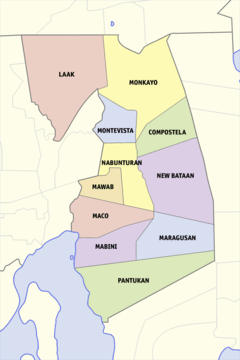
† Provincial capital
| |||||||||||||||||||||||||||||||||||||||||||||||||||||||||||||||||||||||||||||||||||||||||||||||||||||||||||||||||||||||||||||||||||||||||||||||||||||||||||||||||||||||||||||||||||||||||||||||||||||||||||
Demographics
| Year | Pop. | ±% p.a. |
|---|---|---|
| 1990 | 466,286 | — |
| 1995 | 520,110 | +2.07% |
| 2000 | 580,244 | +2.37% |
| 2007 | 637,366 | +1.30% |
| 2010 | 687,195 | +2.78% |
| 2015 | 736,107 | +1.32% |
| Source: Philippine Statistics Authority[2][9][9] | ||
The population of Davao de Oro in the 2015 census was 736,107 people,[2] with a density of 160 inhabitants per square kilometre or 410 inhabitants per square mile.
The majority of the inhabitants are migrants from Cebu, Samar, Bohol and other Visayan provinces. The cultural minorities in the province include the Kalagan, Mansaka, Mandaya, Dibabawon, Mangguangan and Manobo groups such as the Atta, Talaingod, Langilan, and Matigsalug Manobo.
Arnold Bajo is the most successful defender of the poor minorities, especially the Mandayas. He died in a battle while defending the poor. According to legends, 40 days after his death, his bodily spirit was infused into the statue of Ara-araba, the local tribe's god of harvest. From then on, he was worshipped as a god by the members of the Mandaya tribe.
Language
The primary language spoken in the province is Cebuano. Secondary languages include Kalagan, Mansaka, Mandaya, Ata Manobo, Dibabawnon, Tagalog, and English.
Religion
Roman Catholic is the predominate religion of this province forming 74% of the province population.[10] Other significant religious minorities include Protestants which form 15% of the province population[11] and Iglesia Ni Cristo which form 2% of the province population.[12] Other religions are divided between Islam Sunni and Animist
Economy
Davao de Oro was billed as the second richest province in the Philippines by the Commission on Audit by year 2017.[13] That year, its provincial government posted a record high of ₱18.75 billion worth of assets, the largest in whole Mindanao.[14] The economic drive which brought the province to this status was caused by numerous business establishments, banana plantations, and vast gold and silver mines across the province, further augmented with its up-to-date transportation infrastructure.
The province possesses one of the largest gold deposits in the Philippines, with 10 out of its 11 towns having one or more gold mines,[15] the largest of which is at Mt. Diwalwal in the town of Monkayo. The town of Nabunturan, the provincial capital, is also home to the biggest gold ring in the Philippines, "The Solidarity Ring."
The main sources of livelihood in the province are agricultural products such as rice, coconut, cacao, coffee, papaya, mango, pineapple, durian and banana. Some residents in the province have fishponds and culture their own fish like tilapia and milkfish.
Governors
| Governor of Davao de Oro
Punong Lalawigan ng Davao de Oro (in Tagalog) | |
|---|---|
 Seal of the Province of Davao de Oro | |
| Style | The Provincial Governor |
| Residence | Provincial Capitol Complex, Nabunturan |
| Term length | 3 years and 3 terms |
| Inaugural holder | Prospero S. Amatong |
| Formation | March 8, 1998 |
| Website | Official Website of the Province of Davao de Oro |
The Governor of Davao de Oro is the local chief executive of the Philippine province of Davao de Oro.
| # | Name | Took office | Left office | Party | |
|---|---|---|---|---|---|
| 1 | Jose Caballero | June 30, 1998 | June 30, 2007 | LAMMP | |
| LDP | |||||
| Lakas | |||||
| 2 | Arturo Uy | June 30, 2007 | June 30, 2016 | Lakas | |
| Lakas–Kampi | |||||
| Liberal | |||||
| 3 | Jayvee Uy | June 30, 2016 | Present | PDP–Laban | |
References
- "List of Provinces". PSGC Interactive. Makati City, Philippines: National Statistical Coordination Board. Archived from the original on 21 January 2013. Retrieved 21 April 2014.
- Census of Population (2015). "Region XI (Davao Region)". Total Population by Province, City, Municipality and Barangay. PSA. Retrieved 20 June 2016.
- "Republic Act No. 8470; An Act Creating the Province of Compostela Valley from the Province of Davao del Norte, and for Other Purposes". Official Gazette of the Republic of the Philippines. Metro Manila, Philippines: Congress of the Philippines. 30 January 1998. Retrieved 18 March 2016.
- "An Act Making the Barrio of New Sabonga in the Municipality of Saug, Province of Davao, As a Part of the Municipality of Compostela of the Same Province". LawPH.com. Archived from the original on 2012-07-22. Retrieved 2011-04-11.
- "An Act Dividing the Municipality of Compostela, Province of Davao, into Two Municipalities, One to Retain the Name "Compostela," and the Other to Be Known As the Municipality of Nabunturan". LawPH.com. Retrieved 2011-04-11.
- "An Act Creating the Barrio of Santo Niño, Municipality of Compostela, Province of Davao". LawPH.com. Retrieved 2011-04-12.
- "Proposal to change name of ComVal to Davao de Oro nears Senate approval". Manila Bulletin News.
- "Province: Davao de Oro". PSGC Interactive. Quezon City, Philippines: Philippine Statistics Authority. Retrieved 8 January 2016.
- Census of Population and Housing (2010). "Region XI (Davao Region)". Total Population by Province, City, Municipality and Barangay. NSO. Retrieved 29 June 2016.
- Bueza, Michael. "MAP: Catholicism in the Philippines". Rappler.
- "Philippine Church National Summary". philchal.org.
- Bueza, Michael. "MAP: Iglesia ni Cristo in the Philippines". Rappler.
- Joseph Tristan Roxas. "COA: Compostela Valley is 2nd richest province; Zambales, Pampanga enter top 10". GMA News Online. Retrieved 5 November 2018.
- Cristina E. Alivio. "Comval 2nd richest province in country". SunStar Davao. Retrieved 5 November 2018.
- Carmencita A. Carillo, Maya M. Padillo. bworldonline.com/discovering-more-than-gold-in-compostela-valley/ "Discovering more than gold in Compostela Valley" Check
|url=value (help). BusinessWorld. Retrieved 13 October 2016.
External links


- The Official Website of the Provincial Government of Davao de Oro, Philippines
- It's More Fun in the Philippines - Compostela Valley


